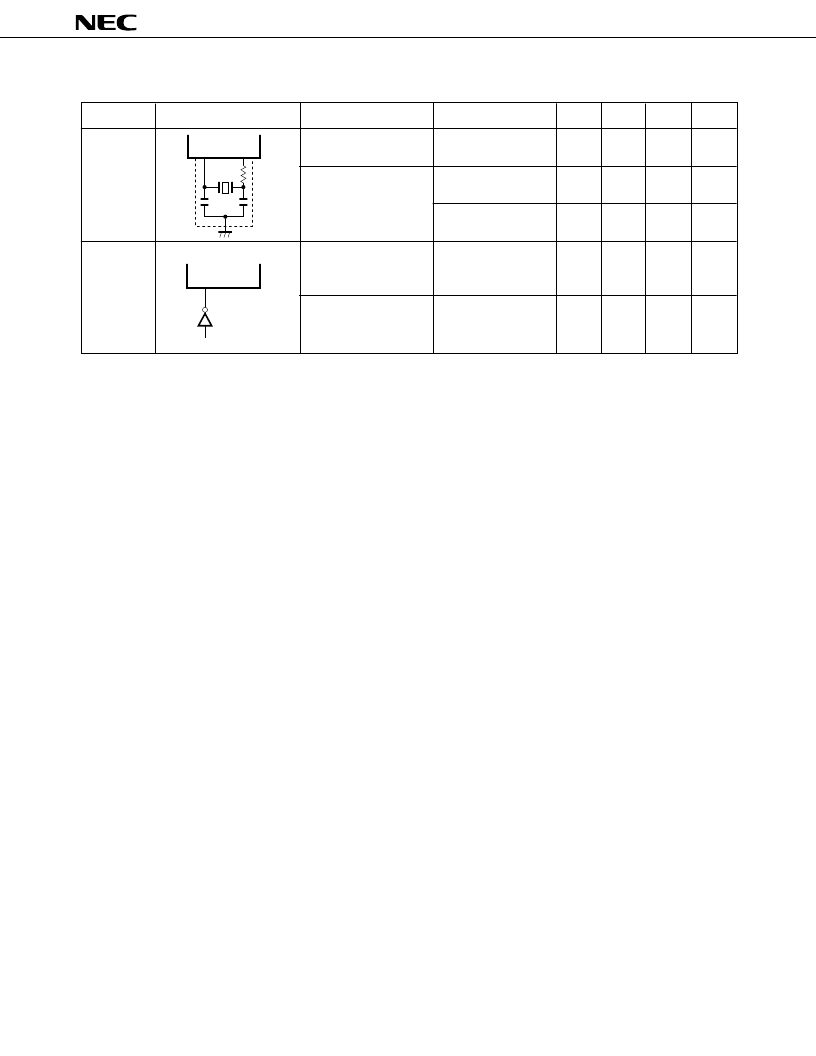- 您現(xiàn)在的位置:買賣IC網(wǎng) > PDF目錄383983 > UPD75212A (NEC Corp.) 4-BIT SINGLE-CHIP MICROCOMPUTER PDF資料下載
參數(shù)資料
| 型號(hào): | UPD75212A |
| 廠商: | NEC Corp. |
| 英文描述: | 4-BIT SINGLE-CHIP MICROCOMPUTER |
| 中文描述: | 4位單片機(jī) |
| 文件頁數(shù): | 49/70頁 |
| 文件大小: | 516K |
| 代理商: | UPD75212A |
第1頁第2頁第3頁第4頁第5頁第6頁第7頁第8頁第9頁第10頁第11頁第12頁第13頁第14頁第15頁第16頁第17頁第18頁第19頁第20頁第21頁第22頁第23頁第24頁第25頁第26頁第27頁第28頁第29頁第30頁第31頁第32頁第33頁第34頁第35頁第36頁第37頁第38頁第39頁第40頁第41頁第42頁第43頁第44頁第45頁第46頁第47頁第48頁當(dāng)前第49頁第50頁第51頁第52頁第53頁第54頁第55頁第56頁第57頁第58頁第59頁第60頁第61頁第62頁第63頁第64頁第65頁第66頁第67頁第68頁第69頁第70頁

49
μ
PD75212A
XT1
XT2
C3
C4
R
SUBSYSTEM CLOCK OSCILLATOR CHARACTERISTICS (Ta = –40 to +85
°
C, V
DD
= 2.7 to 6.0 V)
Oscillator frequency
(f
XT
)
*2
Oscillation stabilization
time
*3
XT1 input frequency
(f
XT
)
XT1 input high and low
level widths (t
XTH
, t
XTL
)
V
DD
= 4.5 to 6.0 V
32.768
1.0
35
2
10
100
32
kHz
s
s
kHz
μ
s
Crystal
resonator
*1
External
clock
32
32
10
MIN.
TYP.
MAX.
UNIT
TEST CONDITIONS
PARAMETER
RECOMMENDED CIRCUIT
RESONATOR
*
1.
Recommended resonators are shown in following page.
2.
Oscillator characteristics only. Refer to the description of AC characteristics for instruction execution time.
3.
Oscillation stabilization time is a time required for oscillation to become stabilized after V
DD
reaches the
minimum value in the oscillation voltage range.
Note
When the subsystem clock oscillator is used, the following should be noted concerning wiring in the area
in the figure enclosed by a dotted line to prevent the influence of wiring capacitance, etc.
The wiring should be kept as short as possible.
No other signal lines should be crossed. Keep away from lines carrying a high fluctuating current.
The oscillator capacitor grounding point should always be at the same potential as V
SS
. Do not connect
to a ground pattern carrying a high current.
A signal should not be taken from the oscillator.
The subsystem clock oscillator is a low-amplitude circuit in order to achieve a low consumption current,
and is more prone to misoperation due to noise than the main system clock oscillator. Particular care is
therefore required with the wiring method when the subsystem clock is used.
XT1
Leave Open
XT2
#
相關(guān)PDF資料 |
PDF描述 |
|---|---|
| UPD75212ACW | 4-BIT SINGLE-CHIP MICROCOMPUTER |
| UPD75212AGF | 4-BIT SINGLE-CHIP MICROCOMPUTER |
| UPD75216 | 4-BIT SINGLE-CHIP MICROCOMPUTER |
| UPD75216A | 4-BIT SINGLE-CHIP MICROCOMPUTER |
| UPD75216ACW | 4-BIT SINGLE-CHIP MICROCOMPUTER |
相關(guān)代理商/技術(shù)參數(shù) |
參數(shù)描述 |
|---|---|
| UPD753012AGC-P33-8BT-A | 制造商:Renesas Electronics Corporation 功能描述: |
| UPD753016AGC-P29-8BT | 制造商:Renesas Electronics Corporation 功能描述: |
| UPD75304GF-407-3B9 | 制造商:Renesas Electronics Corporation 功能描述: |
| UPD75306G182 | 制造商:Panasonic Industrial Company 功能描述:IC |
| UPD75308F478 | 制造商:Panasonic Industrial Company 功能描述:IC |
發(fā)布緊急采購,3分鐘左右您將得到回復(fù)。